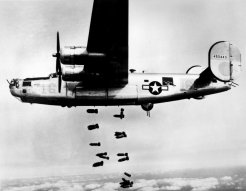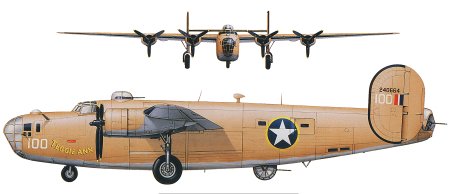
Home »
USA » Consolidated B-24 Liberator
Consolidated B-24 Liberator
Consolidated's B-24 Liberator is often compared unfavourably to the more famous B-17 Flying Fortress. But the B-24 was newer, more efficient and much more versatile than the Boeing design; and with nearly 20,000 aircraft completed, more Liberators were built than any other military aircraft in American history. It was a good bomber, serving on every front, but its most valuable work may have been the war against the U-boats.
The B-24 Liberator was built around the Davis wing; a long, thin, large area structure mounted high on the fuselage. Its twin bomb-bays used 'roller shutter' doors which retracted within the fuselage when opened, reducing drag. The twin tail, like the wing, was a Consolidated trademark. All this resulted in an excellent long-range bomber which had other applications; there were cargo, tanker, patrol, training and reconnaissance variants. Some were armed with even more guns as bomber escorts.
A B-24 caught on the ground at Hickam Field, Hawaii, on 7 December 1941 produced the first American casualties of the war. Liberators fought in the Pacific and China-Burma-India theatres. From the Middle East they attacked their most famous target - Romania's Ploesti oilfields. They also joined with the B-17 in the Eighth Air Force's three year aerial campaign over Europe. The B-24 was never as popular with its crews as the B-17, as it was quicker to catch fire in battle and sometimes suffered hydraulic problems, but it was in some ways a better aircraft, with more modern systems.
The might armada of B-24s went to pasture in just a few years. Soon after the war, Liberators began to disappear from the skies. Today only a couple of surviving examples are airworthy.
 |
 |
 |
| Some late model B-24 Liberator could carry bombs on racks under the inner wing. Anti-submarine versions in RAF service carried rockets. |
Although the Liberator did not carry as many bombs as some other Allied aircraft, it had exceptional performance and massive defensive armament. |
Although not as strong as the B-17, the Liberator was tough enough to bring its crews home in spite of severe damage. |
|
Consolidated B-24 Liberator (Technical Specification) |
| Role |
Heavy bomber with a crew of 10 |
| Manufacturer |
Consolidated |
| Maximum Speed |
488 kmh (300 mph) |
| Maximum Range |
2,896 km (2,850 miles) |
| Ceiling |
9,900 meters (32,500 feet) |
Weight
Empty
Maximum Takeoff |
15,413 kg (34,000 lbs)
27,216 kg (60,000 lbs) |
Dimensions
Wingspan
Length
Height
Wing Area |
33.52 meters (110ft )
20.22 meters (66 ft 4 in)
5.46 meters (17 ft 11 in)
97.36 square meters (1,048 sq ft) |
| Engines |
Four Pratt & Whitney R-1830-43 Twin Wasp radial priston engines each providing 895-kW (1,200 hp) |
| Armament |
One 12.7 mm (0.5 cal) nose gun (some with additional 12.7 mm fixed nose guns)
Two each in dorsal turret, tail turret, retractable ball turret and waist positions plus maximum internal bombload of 3,629 kg (8,800 lbs)
|
Photo Gallery
Click here to submit your photo
| Have A Passion For Aircraft? |
Subscribe to our 14 series FREE newsletter
delivered weekly on World War 2 Aircraft factfile... |
| NB:- We hate spam as much as you do, so your email address will NEVER be shared with or sold to anyone else. That's a Guarantee. |
|
|





